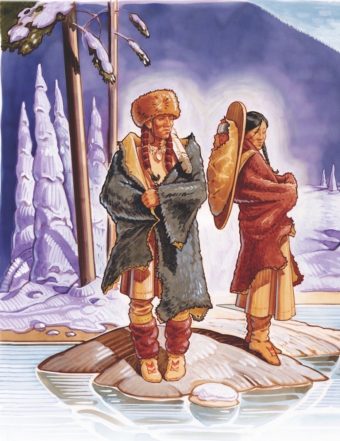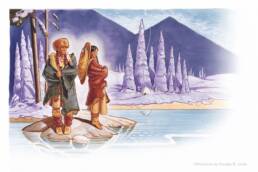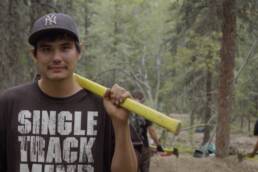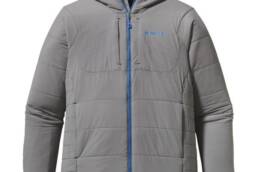Think we’re hard core? Eileen Delehanty Pearkes shows us what the Sinixt Interior Salish First Nations people wore to fend off winter’s elements before European contact.
Climate change can work both ways. Just over 500 years ago, North America entered a Little Ice Age. Between the 16th and 19th centuries, glaciers advanced, ice thickened and snow stayed longer on the ground. It’s hard to imagine, but things didn’t start to warm up around here again until as recently as 1850.
Land-based cultures have always been at the whim of the weather.We can only guess what those years during the Little Ice Age must have been like for early inhabitants of the West Kootenay region, called the Sinixt Interior Salish. Their name for the mountains, rivers and lakes that form their territory — from the height of the Monashees to the height of the Purcells — is Place of the Bull Trout. The bull trout is a distinguishing species, a fish well-adapted to the region’s cold mountain streams and deep lakes.
 Staying warm and fed through long winters without today’s technical gear or central heating required patience and ingenuity. Before European contact, the Sinixt created clothing, food and shelter almost entirely from local materials, using bone needles, stone tools and twine twisted from the fibre of Indian hemp (Apocynum cannabinum).
Staying warm and fed through long winters without today’s technical gear or central heating required patience and ingenuity. Before European contact, the Sinixt created clothing, food and shelter almost entirely from local materials, using bone needles, stone tools and twine twisted from the fibre of Indian hemp (Apocynum cannabinum).
Inside the semi-subterranean lodging for winter villages, floors were cushioned by dried bunchgrass. Beds of woven grass mats were heaped with skins of mountain sheep and goat, as well as bear.Winter was a time of storytelling, handwork and the occasional trip into the forest in search of fresh meat. When a hunter returned with a caribou or deer, the meat was divided equally among all.
Women wore ankle-length deerskin dresses, with leggings underneath. Their work to prepare food for winter storage and hides for clothing was key to survival.
Over the deerskin tunic and leggings, hunters wore outdoor robes of woven mountain goat hair and skins of cougar, bear and coyote. For coldest weather, there were bearskin robes lined with marten skin. Hunters also wore gators of bearskin — fur facing out or in — wrapped around the lower leg.
Caps made of coyote fur kept the head warm. Coyote is a key figure in Sinixt mythology, a trickster and transformer. Mittens of buckskin were stuffed with dried mosses to increase insulation. In more recent times, women made intricately stitched five-fingered gloves with decorated gauntlets.
Women stitched buckskin moccasins with dyed thread spun from mountain goat hair. In the coldest months, feet inside the moccasins were wrapped in lengths of this woven thread. Snowshoes were woven from Douglas maple (Acer glabrum).
Winter energy bars were a form of pemmican stored in animal intestines. They were a mix of bear grease, pulverized dried fish/meat, crushed pine nuts or hazel nuts and dried berries. The Sinixt did not waste anything. Every single animal pelt, bone, antler, fibre of food and drop of grease was put to use in the effort to stay warm and fed through the winter.
Sources: Nancy Wynecoop, Sinixt ancestor who was interviewed by researchers in the 1930s and recorded much of her cultural knowledge in a book titled In The Stream; Hudson’s Bay Company employee John Work; and anthropologists James Teit and Richard Elmendorf.
Eileen Delehanty Pearkes is the author of The Geography of Memory, a history of the Sinixt people in the West Kootenay region.
Related Stories
Goat Style Course Teaser
It's looking good. And big. And sunny. Should be an amazing weekend of mountain bike action at Creston's Goat Style…
Threads MCTV (Gear Review)
Mountain Culture TV: Threads This CMC gear review was shot in Squamish and Whistler B.C. with three high tech…
Goat Style Bike Jam Goes This Weekend
Based in sunny Creston, BC, the Kootenays very own slopestyle competition goes this weekend, attracting some of the…
How Flylow Gear Can Help You Soar
Flylow Gear is a Colorado-based brand that's dedicated to the backcountry. But does it stand up to the rigours of runs…
How Singletrack is Changing the Lives of First Nations Youth
Many First Nations communities in British Columbia are embracing the Aboriginal Youth Bike Program and developing new…
GEAR REVIEW: Patagonia Nano-Air Jacket
You may notice we don't review a ton of gear on here, but when we stumble across certain products we feel we…







